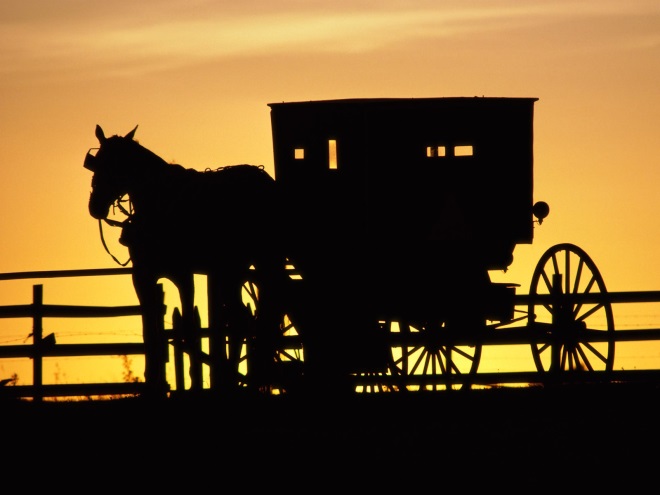I’ve enjoyed our white winter. I prefer white and frozen over brown and muddy… but then as Marilyn likes to remind me, “You don’t have to work outside!”
During the warm, green months, the two of us enjoy Ohio’s Amish Country. The Amish lifestyle, viewed at the speed of a buggy, relieves stress, deepens my breathing and warms the cockles of my heart (although I have no idea what a “cockle” is).
 Marilyn and I regularly overcome busyness by ambling through the idyllic landscapes of Holmes and Wayne County, soaking in the rolling countryside, white clapboard houses and carefully groomed homesteads. Both of us celebrate our farming heritage and so it’s only natural that Amish Country strikes a spiritual as well as an esthetic cord. For us, it’s more than visual—it’s visceral. Each hilltop unveils yet another pastoral portrait worthy of framing. Those bountiful landscapes grace our vision and reduce our heart rate to match the clop of horses’ hooves. Our SUV slows as though it has its own mind. It becomes a time machine transporting us to an era when laundry waved in the breeze while children played softball on dusty diamonds nestled against a one room school house. We are caught up in an out-of-culture experience.
Marilyn and I regularly overcome busyness by ambling through the idyllic landscapes of Holmes and Wayne County, soaking in the rolling countryside, white clapboard houses and carefully groomed homesteads. Both of us celebrate our farming heritage and so it’s only natural that Amish Country strikes a spiritual as well as an esthetic cord. For us, it’s more than visual—it’s visceral. Each hilltop unveils yet another pastoral portrait worthy of framing. Those bountiful landscapes grace our vision and reduce our heart rate to match the clop of horses’ hooves. Our SUV slows as though it has its own mind. It becomes a time machine transporting us to an era when laundry waved in the breeze while children played softball on dusty diamonds nestled against a one room school house. We are caught up in an out-of-culture experience.
We visit and revisit stores like Lehman’s Hardware and Keim Lumber, fascinated by unusual items you can’t find in your local superstore. We smell the aroma of freshly crafted woodwork, and stroke the rich craftsmanship on display in so many of the furniture showrooms.
But it doesn’t take long to realize that Amish tourism has become big business.
I’m sure I’m not the only one who’s considered the strange reversal of roles that has come about by the popularity of Amish tourism. On the one hand, we modernists escape the stress of our commercialized world by pulling the curtains back and peering into the life of the Amish. We find rest—even release—from our harried lifestyle by watching the hard work of an old fashioned lifestyle.
While on the other hand, the Amish—who subject themselves to inconvenience and hard labor for the purpose of avoiding the modern world’s commercialism—have themselves become the unwitting participants in a multi-million dollar Amish tourism industry.
As my friend likes to say, “Wow…didn’t see that comin’!”
Our contemporary society is quickly changing and the truth is, the world is so inter-connected that it is very difficult for anyone to insulate themselves from the changes. Like leaves floating on the surface of a moving stream we are being carried along by forces greater than we can control. As a Bible teacher I feel this very deeply today. We are living in a time in which cultural change is picking up speed like a runaway locomotive. As its passengers, we are either excited about the rapidly changing scenery or frightened by the unknown destination.
Whether you’re excited or concerned about the tsunami of cultural change sweeping our society today—remember, God is in control! Even though the Amish separate themselves from modernity, their simplicity and craftsmanship still manage to quietly influence our modern culture without compromising their values. I hope those of us who are committed to biblical values can do likewise. We don’t have to compromise Biblical values in order to lovingly influence our culture.
Jesus asks us to embrace figuratively those we encounter; and through that embrace transmit His love and simplicity. He uses very common elements to describe how His people should influence culture—telling us; “You are salt…and light…” (Matthew 5:14 & 15).
The Apostle Paul offers an even clearer perspective when he writes, “Let the words you speak always be full of grace. Season them with salt. Then you will know how to answer everyone” (Colossians 4:6).
Change can be unsettling, but it also provides the necessary contrast for God’s light to shine. Go forth and shine!
